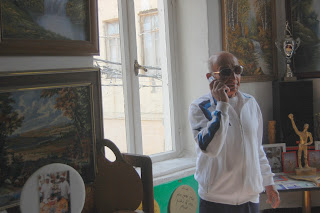Berlin

Considering that it embodies the two evilest empires ever - Nazism and Communism - a quick trip to Berlin revealed a pretty laid back city. Berlin's turbulent history seems to have been successfully subsumed into its flourishing tourist industry while its liberal zeitgeist has transformed it into a magnet for young people.
Berlin's devastation by the Allies and its subsequent West/East division also forged the nature of its revitalization. After the communist side closed off the border, West Berlin's need for working hands led to activist immigration and asylum policies. Today, about 14% of the population of the united city are of foreign nationality while another 12% are descendants of "international migrants" and have either become naturalized German citizens or obtained citizenship by virtue of birth in Germany. With about 25% of the population being "outsiders" it's not surprising that Berlin has become a symbol of the cosmopolitan, global city.
Reminders of Berlin's Jewish life and - more often - death, are scattered around the city. The stunning Jewish Museum tells the whole illustrious and painful story while the controversial, impressive Memorial to the Murdered Jews of Europe (see pic below) covers an entire block but, at least for me, did not have a deep emotional effect. While some visitors seemed to be pensive, others, especially kids, treated the whole affair as a kind of maze, which, of course, it is. An official is on hand to shoo youngsters off the tops of the symbolic gravestones. Whatever your view on the monument, it is but one of many visible signs that Germany society has internalised the lessons of its dark past. Surrounded by sad monuments to the past and by the free roaming grandchildren of the war generation, it was difficult to complain about the way Berlin is transforming itself.
Today, Berlin's community numbers about 12,000 people. We saw armed guards outside every Jewish institution we happened to pass. This was a reminder that while another Holocaust is unthinkable, the Jews of Europe, sadly, still need protection from some of their neighbours.

The nondescript park and parking lot shown below cover the site of Hitler's bunker, the site of his suicide together with Eva Braun. The relatively smart residential buildings in the background were built, in clear view of the West, by the East German authorities for their ruling and intellectual elite in a last ditch effort to show that they too could build stylishly. A neat spot to sum up the last days of these empires. Fake GDR memorabilia can now be purchased from Indian hawkers on street corners while we didn't see any Nazi memorabilia on sale at all, even at the flea market. Thus are the mighty fallen
Decadent Berlin, which the nazis hated, seems to have a sneaky way at poking fun at pompous politicians. The Fernsehturm TV tower (needle with a golf ball on top) - now Berlin's icon -was erected by the communists as a symbol of modernist, secular superiority over the tradition-laden religiosity of the bad old world. Trouble is that at certain times of the day the sun's rays create a cross on the globe, thus gaining it the nickname, The Pope's Revenge.



But all that's behind us now. After reuinification once depressed and still cheaper East Berlin attracted students and artists thereby transforming neglected and grimy neighbourhoods into cheerful places with a bohemian edge and upwardly mobile real estate prices.
You can see more photos of Berlin here
and the whole of my webgallery here




Comments